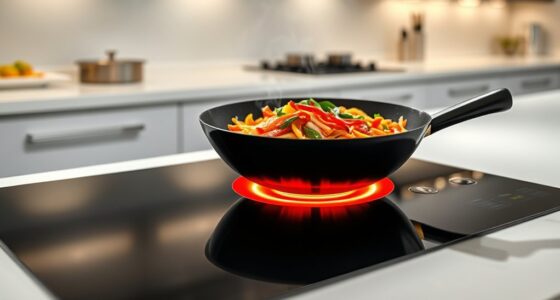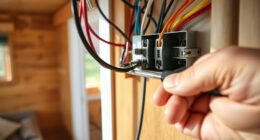Magnetically levitated ceiling fans are revolutionizing quiet cooling with their energy efficiency and minimal noise. By suspending the rotor with magnetic fields, they eliminate mechanical contact, reducing vibration and wear. These fans operate smoothly at low power, often around 3W, and can last over 200,000 hours. If you’re curious about how this innovative technology is changing cooling trends and shaping a more sustainable future, there’s much more to explore.
Key Takeaways
- Magnetic levitation eliminates mechanical contact, significantly reducing noise and vibration for quieter cooling experiences.
- Advanced magnetic control ensures stable, smooth operation, enhancing acoustic comfort in living and working spaces.
- Energy efficiency improvements contribute to eco-friendly, low-noise cooling solutions with minimal maintenance.
- Future innovations will optimize magnetic field management, further decreasing operational noise levels.
- Growing market demand and technological advancements position magnetically levitated fans as the next standard for quiet, sustainable cooling.
How Magnetic Levitation Transforms Ceiling Fan Technology
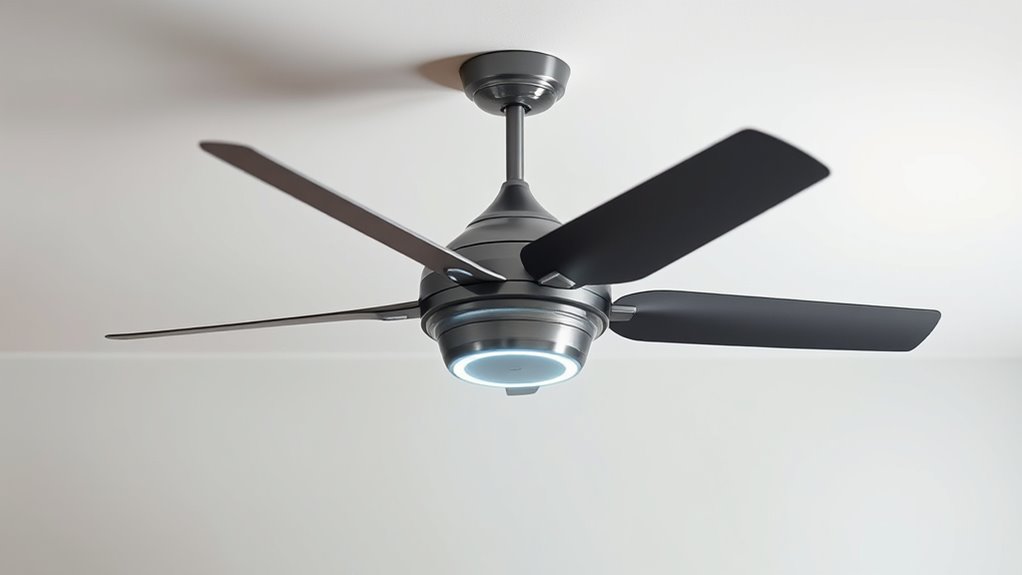
Magnetic levitation revolutionizes ceiling fan technology by eliminating the mechanical friction that traditional bearings rely on. Instead of physical contact, magnetic fields suspend the rotor, reducing energy loss and increasing efficiency. You’ll notice less power needed to spin the blades at high speeds, saving electricity and lowering operating costs. Because there’s no friction, the fan runs more smoothly and quietly, without the noise typical of mechanical bearings. This setup also minimizes wear and tear, making the fan more durable and reducing maintenance needs. With fewer moving parts and no lubricants required, maglev fans last longer and are environmentally friendly. They support sustainability goals by using less energy and producing minimal emissions, all while delivering reliable, quiet airflow for your space. Magnetic field control allows for precise rotor positioning, further enhancing performance and stability. Additionally, advancements in magnetic levitation technology have made these fans more accessible and cost-effective for residential use.
The Science Behind Maglev Fan Operation
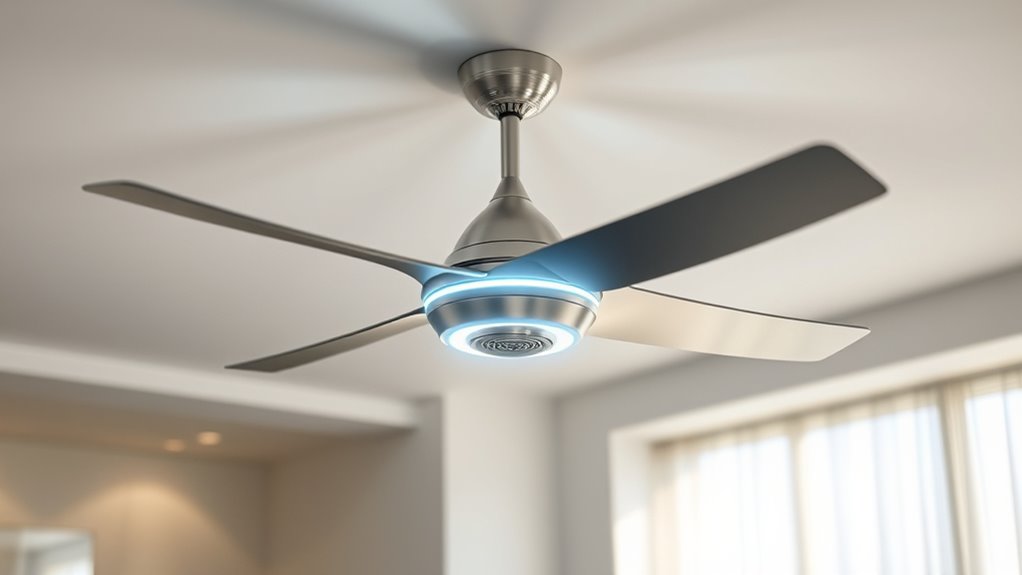
You can understand how maglev fans stay suspended and rotate smoothly by exploring the magnetic levitation mechanics, which eliminate contact and friction. The electromagnets and rotor work together through dynamic electromagnetic interactions, creating a stable and responsive system. Optimizing the magnetic fields guarantees efficient, high-speed operation while maintaining precise control over the fan blades. Material selection plays a crucial role in ensuring the magnetic properties are suitable for consistent levitation performance. Additionally, magnetic field control techniques are essential for adjusting levitation stability and responsiveness during operation.
Magnetic Levitation Mechanics
Magnetic levitation in ceiling fans operates by carefully balancing forces that attract and repel magnets, allowing the rotor to float without physical contact. Magnets on the rotor and stator generate forces that oppose gravity, stabilizing the fan blades in midair. The push and pull interactions are finely tuned to keep the rotor suspended and aligned, enabling near-frictionless rotation. Precise magnetic field control, using sensors and switching magnet polarities, maintains stability and prevents wobbling. Electromagnets provide adjustable lift and positioning, while permanent magnets supply a baseline magnetic field, reducing power needs. This controlled magnetic interaction is essential for maintaining the levitation and stability of the fan. This hybrid system eliminates mechanical bearings, markedly decreasing wear, noise, and energy consumption. Additionally, advanced sensor technology continuously monitors the rotor’s position to ensure smooth operation and optimal stability. The result is a quieter, more efficient ceiling fan that operates smoothly with minimal mechanical contact.
Electromagnet and Rotor Dynamics
Electromagnets in magnetically levitated ceiling fans generate dynamic magnetic fields that drive rotor movement without physical contact. These electromagnets are strategically placed around the stator to produce a rotating magnetic field, which induces the rotor to spin. Unlike traditional motors, this setup eliminates mechanical friction, boosting efficiency. The rotor, magnetically levitated within this field, relies on a delicate balance of forces for levitation stability. Gyroscopic effects help maintain smooth rotation at high speeds, while nutation dynamics influence stability by altering the rotor’s tilt angle. Achieving stable levitation depends on maintaining equilibrium between magnetic forces and gravity. This precise interaction enables quiet, efficient operation, reducing wear and noise while supporting the futuristic design of maglev ceiling fans. Additionally, body awareness techniques from somatic therapy can enhance understanding of physical sensations related to vibration and movement, contributing to the optimization of magnetic levitation systems for quieter and more efficient operation.
Magnetic Field Optimization
Optimizing magnetic fields is key to enhancing the performance of magnetically levitated ceiling fans. By fine-tuning magnetic flux density and permanent magnet placement, you can considerably boost efficiency and airflow. Here’s how:
- Adjust magnetic flux density to increase driving force, improving fan power without extra energy.
- Experiment with permanent magnet placement to maximize magnetic coupling and reduce energy loss.
- Use simulation tools like MotorWizard to refine rotor geometry and magnet arrangement.
- Conduct experimental tests to identify the best magnetic configurations for ideal performance. Magnetic field optimization can also lead to reduced operational noise, making fans more suitable for quiet environments. These techniques help you achieve quieter operation, higher ionic wind velocity, and better cooling efficiency. Proper magnetic field optimization ensures your fan operates smoothly, with less noise and lower power consumption, making it a smarter, more efficient cooling solution. Additionally, understanding the role of magnetic materials can further enhance the overall system performance.
Benefits of Energy Efficiency With Maglev Fans
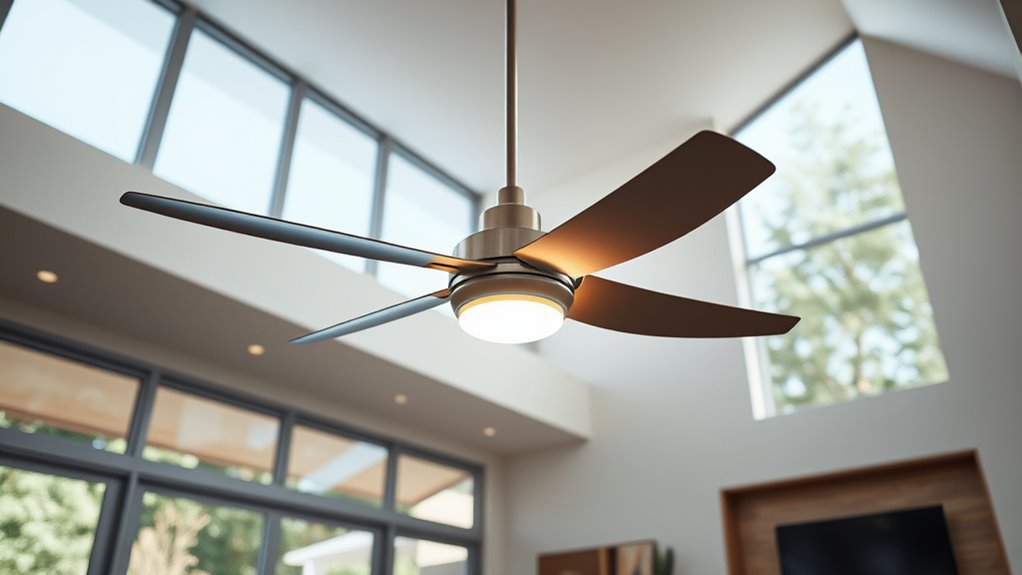
Maglev fans deliver significant energy savings compared to traditional ceiling fans by eliminating mechanical bearings, which reduces friction and power loss. They consume around 28-35 watts, with some models operating below 10 watts while still providing effective airflow. Even fans as low as 3W can offset room temperature rises, cutting cooling energy needs by about 30%. When combined with air conditioning, energy savings can reach up to 70%. The advanced BLDC motors used in maglev fans are 50-60% more efficient than conventional motors, thanks to magnetic levitation and reduced mechanical drag. Magnetic levitation technology also minimizes maintenance requirements and extends the lifespan of the fans. Additionally, the energy efficiency benefits of maglev fans contribute to reduced electricity bills and a smaller carbon footprint. Smart control systems optimize power use by adjusting speed precisely, ensuring minimal energy consumption without sacrificing cooling performance. Overall, maglev fans help lower electricity demand and support eco-friendly, sustainable operation.
Noise Reduction and Quiet Performance Advantages
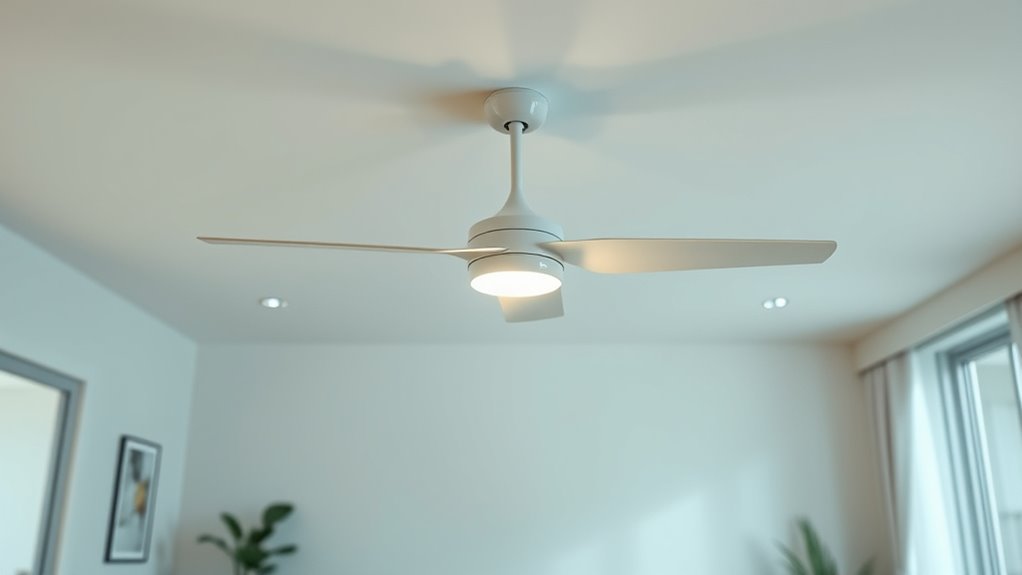
Magnetic levitation technology markedly reduces noise in ceiling fans by eliminating physical contact between moving parts, which minimizes friction and vibration. This results in quieter operation and less mechanical noise. You’ll notice several advantages:
Magnetic levitation fans operate quietly by eliminating contact and reducing vibration for a peaceful environment.
- Low operational noise—typically between 20 dB(A) and 25 dB(A), comparable to or quieter than standard fans.
- Reduced vibration noise—no physical contact means less vibration, enhancing overall quietness.
- Smooth airflow—designed for turbulence-free airflow, further decreasing noise levels, and precision engineering contributes to enhanced performance.
- Consistent performance—stable operation maintains low noise even at higher speeds. MagLev fans also experience less wear and tear, prolonging their lifespan and maintaining quiet operation over time.
These features make magnetic levitation fans ideal for quiet environments, offering a peaceful cooling experience without sacrificing performance. Their noise reduction capabilities set them apart from traditional fans, ensuring a quieter, more comfortable space.
Innovative Motor Designs and Magnetic Suspension
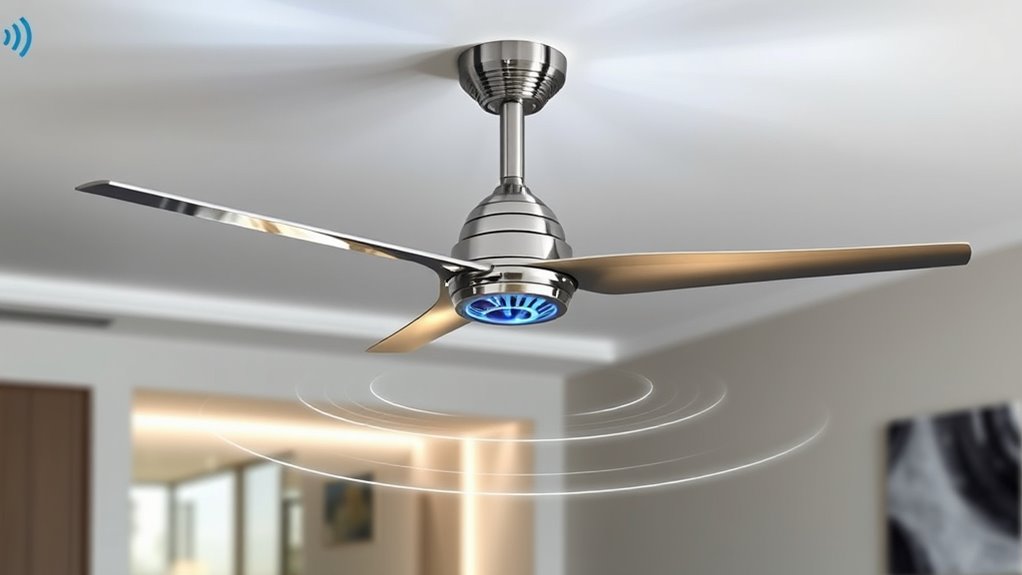
You can benefit from innovative motor designs that use electromagnetic rotor dynamics to achieve high efficiency and durability. Magnetic suspension mechanics eliminate physical contact, reducing friction and wear on moving parts. This combination results in quieter operation, longer lifespan, and more stable high-speed performance. Additionally, advancements in technology integration allow for smarter control and energy management of these fans.
Electromagnetic Rotor Dynamics
Electromagnetic rotor dynamics play a crucial role in the development of innovative ceiling fan motors, enabling precise control over torque and speed. You benefit from this through:
- Magnetic interaction between the stator field and rotor magnets, generating smooth torque.
- Optimized rotor geometry and magnet placement, enhanced by multi-physics simulations, to maximize efficiency.
- Controlled current excitation in the stator windings, stabilizing torque across various speeds.
- High-performance materials like neodymium magnets and advanced lamination stacks, reducing losses and boosting durability.
These factors ensure the motor delivers high torque at low speeds, improves energy efficiency, and maintains quiet operation. Precise electromagnetic control also allows for compact, reliable, and maintenance-free ceiling fan designs, paving the way for quieter, more efficient cooling solutions. Electromagnetic rotor dynamics play a vital role in achieving these performance benefits.
Magnetic Suspension Mechanics
Innovative motor designs leveraging magnetic suspension eliminate the need for mechanical bearings by using magnetic forces to levitate and stabilize the rotor. You’ll find that magnetic repulsion or attraction keeps the rotor suspended without physical contact, reducing friction and noise. Permanent magnets or electromagnets generate stable levitation forces, enabling near-frictionless rotation that boosts energy efficiency and minimizes wear. Precise control systems, including sensors and feedback mechanisms, are essential to maintain rotor position, preventing contact with stator components. These designs often combine brushless DC motors with magnetic bearings, creating compact architectures that improve airflow while eliminating maintenance needs. Advanced materials, like neodymium magnets and soft magnetic composites, enhance stability and performance. This innovative approach significantly reduces mechanical wear and extends the lifespan of ceiling fans. Incorporating magnetic suspension technology can also lead to better vibration damping, contributing to quieter operation. Overall, magnetic suspension mechanics revolutionize ceiling fan design by offering silent, efficient, and durable operation.
Durability and Low Maintenance Features of Maglev Fans
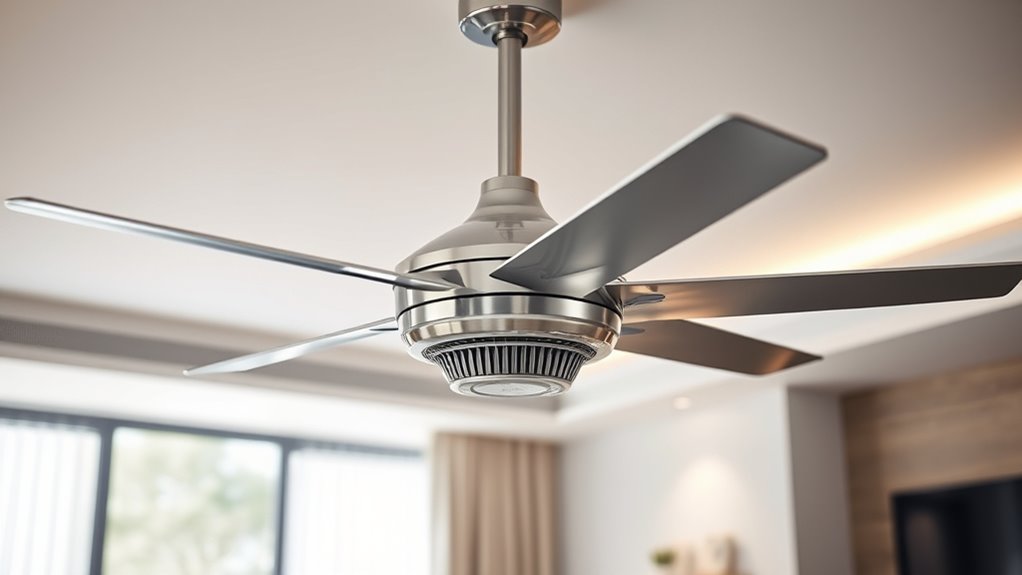
Magnetically levitated ceiling fans stand out for their exceptional durability and low maintenance requirements. Thanks to magnetic levitation, there’s no physical contact between moving parts, greatly reducing wear and tear. This results in several benefits:
- They last over 200,000 hours—much longer than traditional fans, which typically last around 40,000 hours.
- The sealed design prevents dust and particles from entering, minimizing internal contamination.
- No lubrication or bearing replacements are needed, cutting down on routine upkeep.
- Maintenance mainly involves occasional external cleaning and visual checks, saving you time and costs.
Furthermore, the absence of physical contact reduces vibrations, which contributes to quieter operation and extends component lifespan. Because of these features, maglev fans deliver reliable performance with considerably fewer breakdowns and less intervention, making them a smart, durable choice for modern cooling needs. Additionally, their advanced magnetic technology ensures consistent efficiency and performance over decades of use.
Comparing Traditional and Magnetically Levitated Fans
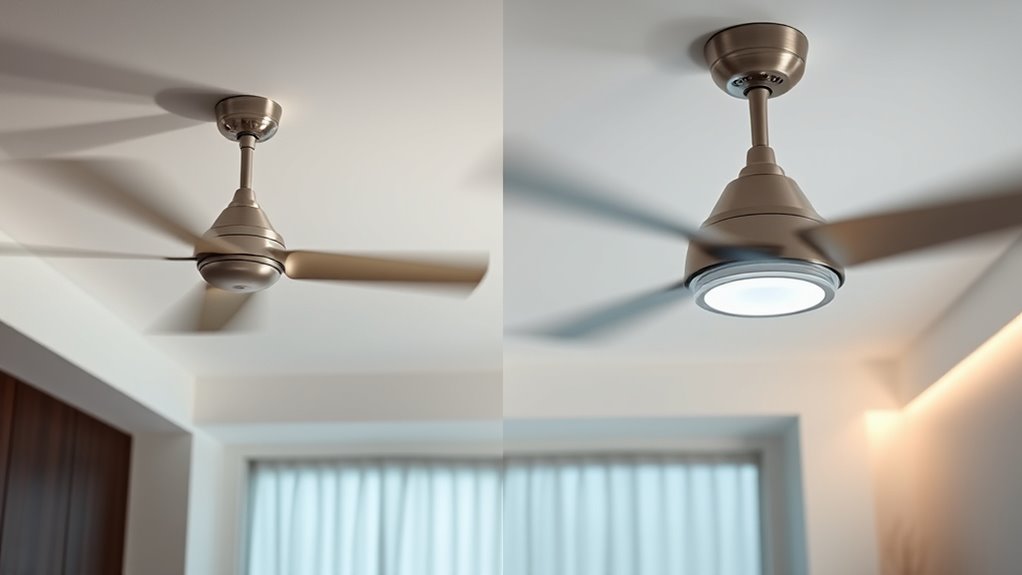
You’ll notice that maglev fans eliminate contact between moving parts, making them safer and quieter than traditional fans with exposed blades. They also use less energy and run more smoothly, reducing noise and power consumption. Comparing these features helps you understand the practical benefits of upgrading to magnetically levitated ceiling fans. Enhanced durability due to the absence of mechanical friction contributes to a longer lifespan and lower maintenance costs.
Mechanical Contact Differences
Have you ever wondered how the mechanical contact differs between traditional ceiling fans and those with magnetic levitation? Traditional fans rely on mechanical bearings like ball or sleeve bearings, which create friction and wear over time. In contrast, magnetically levitated fans eliminate physical contact by suspending blades with magnetic fields, reducing friction substantially. This innovative approach employs electromagnetic forces to suspend and stabilize the blades, removing the need for physical contact. Here’s what sets them apart:
- Traditional fans use mechanical bearings, while levitated fans suspend blades without contact.
- Magnetic levitation minimizes wear, extending the fan’s lifespan.
- Electromagnets control blade movement, replacing induction motors.
- The reduced mechanical contact results in smoother operation and less maintenance.
This design difference not only enhances durability but also improves operational efficiency and longevity.
Energy and Noise Benefits
Compared to traditional ceiling fans, magnetically levitated models offer notable energy and noise advantages. They use DC motors, which can cut energy consumption by up to 70%, operating effectively at very low wattages like 3W. This results in significant savings on electricity bills and reduces environmental impact. Their design minimizes energy waste, making them more efficient than traditional AC motor fans. Noise levels are greatly decreased because magnetic levitation eliminates mechanical contact, creating a quieter and more peaceful environment. These fans are ideal for bedrooms, offices, or any space where silence matters. Their quiet operation, combined with energy efficiency, enhances user comfort and satisfaction. Plus, their low power use makes them versatile, even allowing for battery operation during power outages.
Market Trends and Adoption of Maglev Ceiling Fans
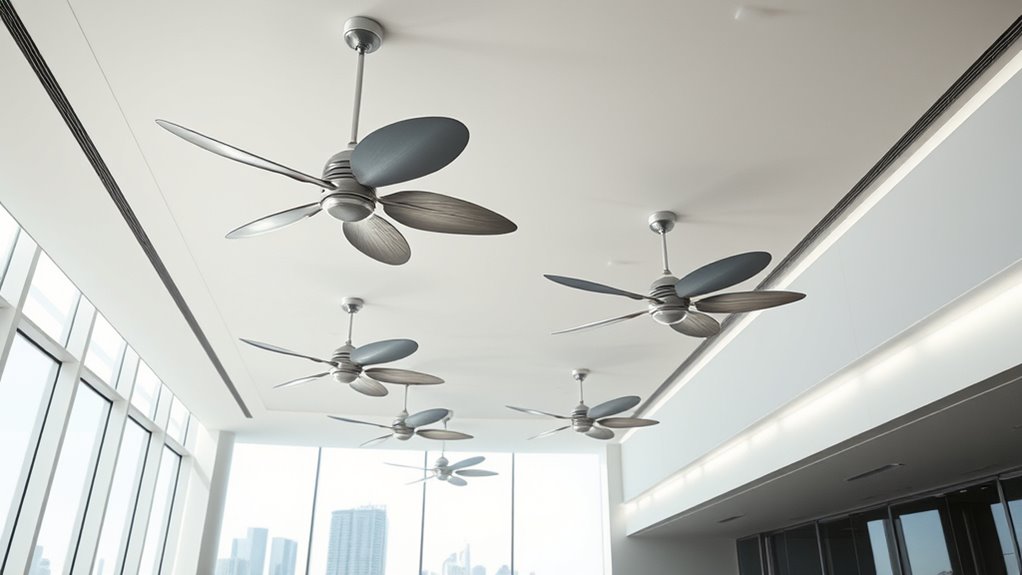
The adoption of magnetically levitated (maglev) ceiling fans is gaining momentum as consumers seek quieter, more durable, and energy-efficient solutions. Market growth reflects this trend, with the overall ceiling fan market valued at around USD 12.44 billion in 2025 and projected to reach USD 15.23 billion by 2030. Here’s what’s driving adoption:
- The rise of smart features like IoT connectivity, voice control, and automation.
- Growing demand for energy-efficient models, especially those with BLDC motors.
- Consumer preference for sleek, minimalist designs that blend with modern interiors.
- Increased urbanization and rising disposable incomes in emerging markets.
Market size valued at USD 14.6 billion in 2025; projected to reach USD 31.6 billion by 2035. As these trends continue, maglev ceiling fans are set to become an integral part of future smart, efficient, and silent cooling solutions.
Challenges and Future Developments in Maglev Fan Technology
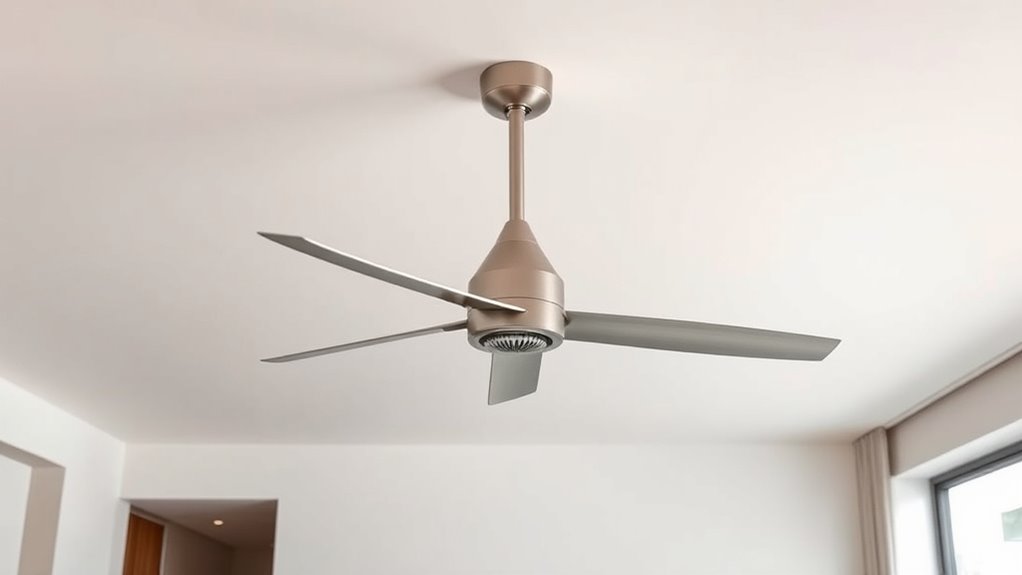
Overcoming the technical challenges of maglev fan technology requires precise control of magnetic fields to guarantee stable levitation and minimize vibrations. You need advanced electromagnetic management to prevent rotor wobble and ensure smooth operation. Minimizing frictional losses demands magnetic bearings that eliminate mechanical contact, but this introduces issues like electromagnetic interference (EMI) that could disrupt nearby electronics. Balancing magnetic forces with fan blade weight calls for optimized materials, while durability remains a hurdle under continuous use and environmental factors such as humidity and dust. Power efficiency benefits from DC motors paired with magnetic bearings, reducing energy loss, but designing reliable power supplies and electronics for seamless control is complex. Addressing these challenges drives innovation toward more stable, efficient, and durable maglev fans. Magnetic control precision is critical for advancing the reliability of these systems in real-world applications.
The Impact of Maglev Fans on Sustainable Living
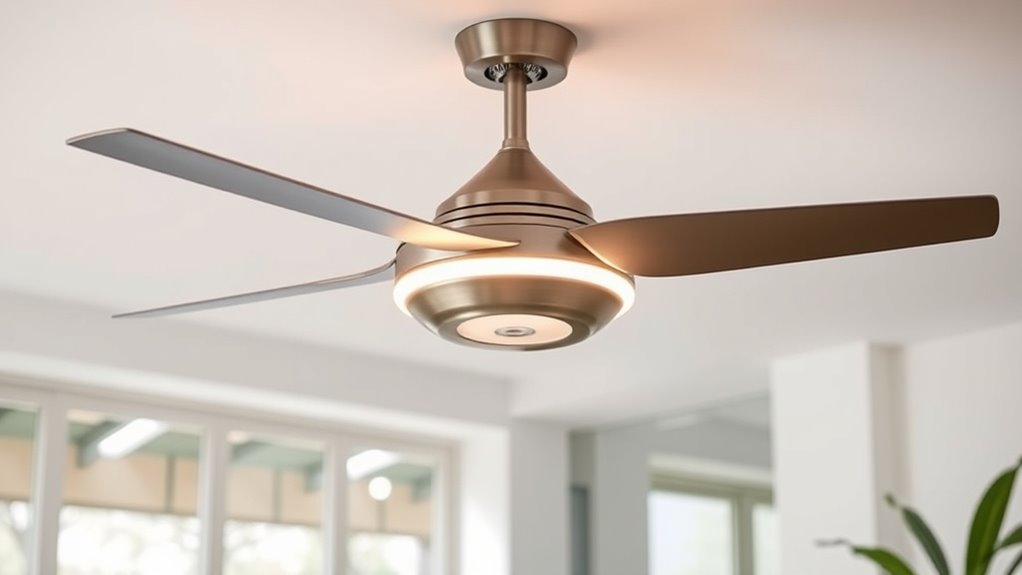
Maglev ceiling fans substantially contribute to sustainable living by reducing energy consumption and minimizing environmental impact. They use about 30% less energy than traditional fans thanks to magnetic levitation bearings, which cut mechanical friction. Typically consuming just 10 to 35 watts, they save up to 70% energy when paired with air conditioning. Fans with brushless DC or switch reluctance motors further cut power use by 50-60%. Their low energy needs enable operation on batteries, helping during outages and lowering reliance on grid power. Additionally, integrated LED lighting adds functionality while maintaining low energy use.
- Cut electricity demand and greenhouse gas emissions.
- Minimize maintenance, reducing waste.
- Lower carbon footprint with efficient motors.
- Support global climate efforts through reduced energy peaks.
Frequently Asked Questions
What Are the Initial Costs of Installing Maglev Ceiling Fans?
When you ask about the initial costs of installing maglev ceiling fans, keep in mind that specific prices aren’t detailed yet. Overall, installation costs for high-tech fans can be higher than standard models due to complex wiring, specialized labor, and advanced features. You might spend between $300 and $700 or more, depending on your home’s electrical setup, fan size, and additional features. Expect higher costs initially, but potential savings in energy and durability later.
How Do Maglev Fans Perform in Different Climate Conditions?
Like a chameleon adapting to its environment, maglev fans perform reliably across various climates. You’ll notice lower internal temperatures and reduced noise in hot, humid, or dry conditions. They resist moisture damage, operate efficiently, and require less maintenance. Thanks to magnetic levitation, they stay stable and cool, even in extreme temperatures. This adaptability means you can depend on their consistent performance, regardless of climate challenges.
Are Maglev Ceiling Fans Compatible With Existing Home Automation Systems?
You can make your maglev ceiling fan compatible with your existing home automation system by installing a compatible smart controller or hub. Check if the fan supports protocols like Zigbee, Z-Wave, or Wi-Fi, and verify your wiring meets the requirements. Once connected, you can control the fan’s speed, lighting, and automation features through apps or voice commands, seamlessly integrating it into your smart home setup.
What Safety Features Are Incorporated Into Maglev Fan Designs?
Safety features in maglev fan designs are the backbone of peace of mind—think of it as having your cake and eating it too. You benefit from automatic restart, polarity protection, and CE safety approval, ensuring reliable operation. The Vapo bearing system and hermetically sealed design cut down on wear and contamination. Plus, safety certifications like IP55 and ATEX guarantee the fan’s resilience in tough environments, keeping you safe and secure.
Can Maglev Technology Be Integrated Into Outdoor or Industrial Fans?
You can definitely integrate maglev technology into outdoor or industrial fans, but it’s not without challenges. The key is selecting durable materials that withstand harsh conditions like moisture and extreme temperatures. You’ll also need to contemplate power efficiency and noise reduction benefits. While scale-up and cost are hurdles, ongoing research aims to make maglev fans more practical and affordable, opening the door for broader application in tough environments.
Conclusion
Embracing maglev ceiling fans means you’re staying ahead of the curve and making smarter choices for quieter, more efficient cooling. These innovative fans are truly a game-changer, combining cutting-edge technology with eco-friendly benefits. While there are hurdles to overcome, the future looks bright for this quiet revolution. So, don’t let the grass grow under your feet—jump on the bandwagon now and enjoy the cool breeze of progress!
I’m Theodore, and I love tiny houses. In fact, I’m the author of Tiny House 43, a book about tiny houses that are also tree houses. I think they’re magical places where imaginations can run wild and adventures are just waiting to happen.
While tree houses are often associated with childhood, they can be the perfect adult retreat. They offer a cozy space to relax and unwind, surrounded by nature. And since they’re typically built on stilts or raised platforms, they offer stunning views that traditional homes simply can’t match.
If you’re looking for a unique and romantic getaway, a tree house tiny house might just be the perfect option.




